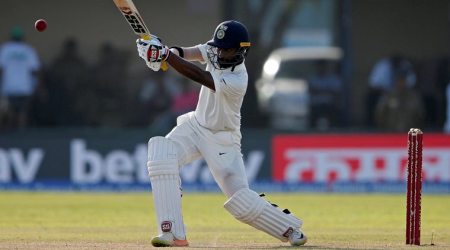 Coming into the Test, Ravindra Jadeja was already on three demerit points after running on the pitch during the Indore Test against New Zealand last year. (File photo)
Coming into the Test, Ravindra Jadeja was already on three demerit points after running on the pitch during the Indore Test against New Zealand last year. (File photo)
Why was Ravindra Jadeja suspended for the third Test?
The left-arm spinner was suspended because he had accumulated six demerit points inside a 24-month period. Coming into the Test, he was already on three demerit points after running on the pitch during the Indore Test against New Zealand last year. He accumulated another three points because he threw the ball at Sri Lankan batsman Dimuth Karunaratne “in a dangerous manner”. This breached article 2.2.8 of the players’ code of conduct which concerns “throwing a ball (or any other item of cricket equipment such as a water bottle) at or near a Player, Player Support Personnel, Umpire, Match Referee or any other third person in an inappropriate and/or dangerous manner during an International Match”.
How does the system work?
Implemented from October last year, players will be slapped with demerits points if they breach the ICC’s code of conduct. Punishments, usually fines, will remain for minor offences such as showing dissent and using obscene language. But for offences like running on the pitch or any on-field altercations with players or throwing the ball in a dangerous manner or any inappropriate physical contact, players will be given demerit points, based on the gravity of the incident. If they accumulate four or more demerit points within a 24-month period, they will be converted into suspension points and the player will be banned. Two suspension points equate to a ban from one Test or two ODIs or two T20Is, whatever comes first for the player.
But if they pick up two demerit points before October 2018, the player will face the penalty of a two-Test/four-ODI/four-T20I suspension. The catch is that even if you have served the ban, the demerit points will be wiped off from the disciplinary record only after October 2018. This is apart from the fine.
Which are the previous instances?
South Africa pacer Kagiso Rabada was the first player to be punished thus. He incurred the first three points when he stumbled into Sri Lankan batsman Niroshan Dickwella at the non-striker’s end even after the latter had completed he single in an ODI in Cape Town. Then, in the first Test against England, he was slapped with one point for an elaborate send-off to England batsman Ben Stokes. Dickwella, too, was suspended for a couple of ODIs after he hoarded more demerit points for “showing dissent against the umpire” during a T20 match against Australia.
Why is the rule a little harsh on players?
For ages, cricket has kept itself away from such hard-binding rules and regulations. But the rather stifling diktat takes a certain charm out of the game. Imagine a cricket field where players don’t stare at each other, indulge in some lighthearted banter, the accidental collision, or even a batsman suppressing his frustration when he feels that he’s genuinely not out. It becomes machine-like. Moreover, it can impact matches and series. While India may not be affected by Jadeja’s suspension, as they have already won the series, South Africa were demoralised when Rabada was suspended, though eventually they went on to win the Test. Imagine this happening to an important player in the World Cup final or an Ashes decider.
How has the cricket world reacted to it?
Rabada’s suspension was blasted by several former players. Kevin Pietersen, never one to shy away from expressing his opinion, sarcastically tweeted: “A DYING global Test game & the @ICC <http://twitter.com/ICC> suspend a player for a naughty word! Rabada is a STAR! More stars OUT the game damages the game! On Test Match Special, former South African skipper Graeme Smith vehemently criticised match referee Jeff Crowe: “He’s been out on this pitch every morning. Where’s he hiding?”
What’s a more pragmatic alternative?
Unless the offence is serious, like ball tampering or causing physical hurt, players can be just docked off their match fees, according to the level of offence. The stricter rules just make the game more rigid.






